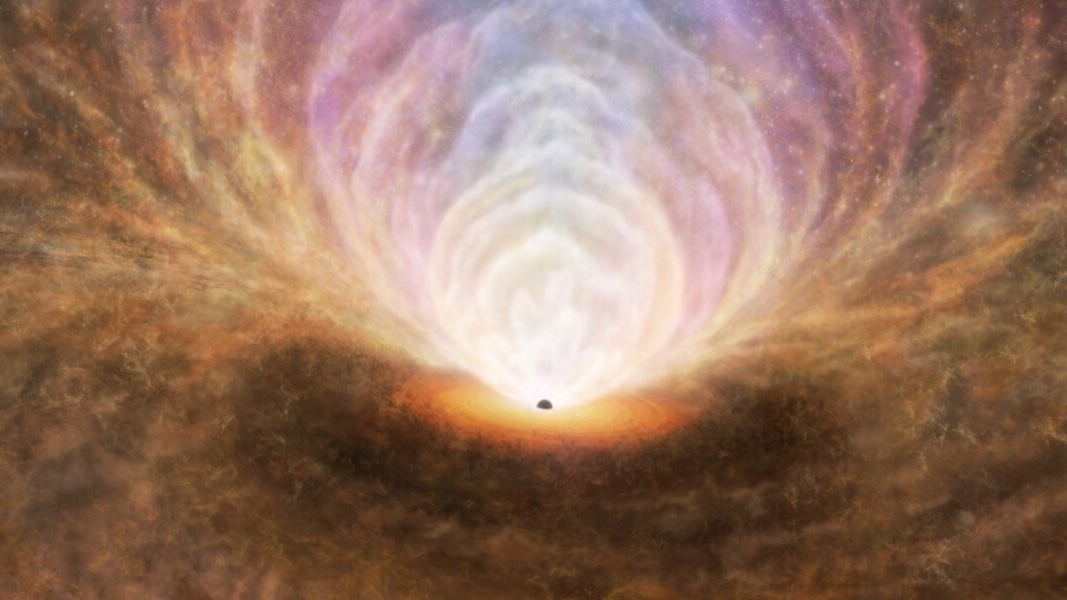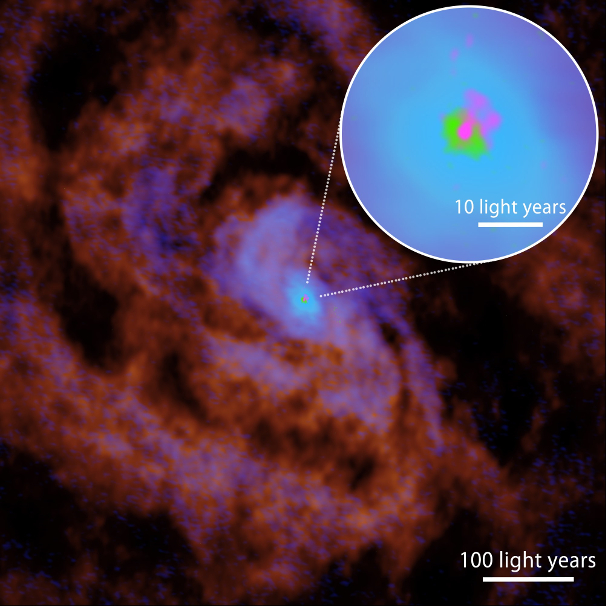Supermassive black holes are messy eaters big on recycling
At the heart of a distant galaxy, scientists saw a fountain of material moving away from the central supermassive black hole — and back.

Astronomers have peered into the active heart of a distant galaxy to observe the feeding habits of a supermassive black hole — in short, they discovered that it recycles material. These findings could help us better understand the dynamics of how supermassive black holes grow.
Supermassive black holes exist at the hearts of most, if not all, galaxies, with masses of millions or even billions of times that of the sun. In some cases, these black holes are surrounded by matter they feed on, in the form of plate-like disks called accretion disks, and scientists think it's those disks that enable them to grow. The gravitational force of the central black hole whips the accretion disk matter around at incredible speeds and generates immense tidal forces in the gas and dust. As this matter is churned, it glows so brightly it can often outshine the combined light of every star in the galaxy around it. These luminous central galactic regions are called active galactic nuclei (AGNs).
Now, an international team of scientists observed the AGN of the Circinus Galaxy, located around 13 million light-years away from Earth, with the Atacama Large Millimeter/submillimeter Array (ALMA). This revealed the intricate dance of gas around the feeding supermassive black hole at the heart of the AGN, and the team managed to see the true feeding mechanism of the black hole.
Related: Very Large Telescope surprisingly finds exoplanet lurking in 3-body star system
It appeared that gravitational instability associated with the disk is driving material toward the black hole. They also found, however, the black hole in question only consumes around 3% of the matter flowing toward it. The rest seems to be pushed away by the energy of the AGN itself, but those outflows of material then appeared to eventually fall back to the supermassive black hole. It was like a recycling process, not dissimilar to a water fountain here on Earth.
"Detecting accretion flows and outflows in a region just a few light-years around the actively growing supermassive black hole, particularly in a multiphase gas, and even deciphering the accretion mechanism itself, are indeed monumental achievements in the history of supermassive black hole research," Takuma Izumi, research leader and an assistant professor at the National Astronomical Observatory of Japan (NAOJ), said in a statement.
Gas accretion mechanisms have been studied before on the scale of whole galaxies — around 100,000 light-years in width — down to an AGN alone, which is a few hundred light-years in width. However, the dynamics of gas accretion in an AGN on the scale of just a few dozen light-years had previously remained unresolved.
Breaking space news, the latest updates on rocket launches, skywatching events and more!
That was a problem because, to really understand how black holes grow, it is necessary to see how much gas flows into them and how much they push away. An understanding of the form this gas takes is also needed — that is, how much of it is a superheated plasma of separated electrons and protons? How much is a gas of whole atoms? And how much is cold molecular gas?
Understanding all this means looking into anAGN on rather small scales and accounting for the complex motions of that flowing material. This team was able to do this with the Circinus Galaxy's AGN using the high-resolution power of ALMA. The researchers, in essence, differentiated foreground molecular gas, which absorbs light from the brightly shining background AGN. Basically, because that light-absorbing material is always moving away from Earth, the team was able to capture the accretion flow into the AGN.
The team also saw some gravitational instability acting as a feeding mechanism for the supermassive black hole. This came about, the researchers say, because the accretion disk was experiencing a gravitational force so great that the motion of the disk itself couldn’t balance it out. This means the gas disk essentially collapses under its own weight and can’t maintain stable motion in the AGN. Not only does this generate complex structures within the disk, but it also sends gas speeding toward the central supermassive black hole.
One of the significant outcomes of this research is the determination of how much matter this supermassive black hole is actually consuming, which the team could see via the density of the gas they measured and the rate at which it was flowing to the AGN.
What this showed was the amount of gas flowing toward the black hole was around 30 times more than what is needed to sustain the AGN's activity. That means most of the matter flowing to the black hole isn’t actually playing a role in its growth.
ALMA saw the surplus matter getting expelled as outflows, but at speeds too slow to escape the supermassive black hole in full. This resulted in the expelled matter being dragged back to the accretion disk, from where it is eventually recycled back into the black hole.
To confirm this recycling action is common in AGNs, the team now intends to take a look at other supermassive black holes with ALMA and further future telescopes.
"To comprehensively understand the growth of supermassive black holes in cosmic history, we need to investigate various types of supermassive black holes located farther away," Izumi concluded. "This requires high-resolution and high-sensitivity observations, and we have high expectations for the further use of ALMA and for upcoming large radio interferometers in the next generation."
The team’s research was published on Friday (Nov. 3) in the journal Science.

Robert Lea is a science journalist in the U.K. whose articles have been published in Physics World, New Scientist, Astronomy Magazine, All About Space, Newsweek and ZME Science. He also writes about science communication for Elsevier and the European Journal of Physics. Rob holds a bachelor of science degree in physics and astronomy from the U.K.’s Open University. Follow him on Twitter @sciencef1rst.

